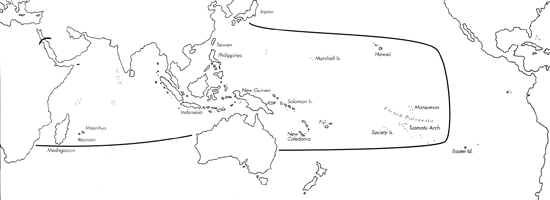Range: E. Africa to Hawaii.
Description: Medium- sized to moderately large, moderately solid to solid. Last whorl usually conical; outline straight, concave below shoulder. Shoulder angilate. Spire low; outline usually concave, occasionally convex in early whorls. Larval shell multispiral, maximum diameter about 0.8 mm. Early postnuclear whorls tuberculate. Teleochonce sutural ramps flat, with 1-3 spiral grooves disappearing in late whorls. Last whorl with coarse, widely spaced, partially granulose spiral ribs basally, sometimes replaced by obsolete smooth ribs or followed by scattered spiral rows of granules to shoulder.
| Shell Morphometry | ||
|---|---|---|
| L | 40-75 mm | |
| RW | 0.20-0.60 g/mm | |
| (L 40-60 mm) | ||
| RD | 0.51-0.60 | |
| PMD | 0.83-0.95 | |
| RSH | 0.04-0.13 | |
Ground colour white. Last whorl overlaid with brownish olive or orangish to dark brown, leaving spiral groundcolour bands at shoulder and below centre. White bands solid, regularly or irregularly interrupted by axial colour markinngs, or covered with olive to dark brown. Base dark brown. Larval whorls and adjacent sutural ramps grey. Late ramps with confluent radial blotches matching last whorl pattern in colour. Aperture white or pale brown-dark brown at base.
Periostracum light brown, thin, translucent to opaque, with widely spaced tufted spiral ridges on last whorl.
In Hawaii and Marshall Is., animal olive, sparsely to heavily mottled with darker grey, black and dark brown, often variably dotted with white. Proboscis yellow. Siphon, rostrum and tentacles may appear grey, dark brown or even black depending on mottling and absence of white dots (Kay, 1979: Kohn, unpubl. observ.; Pearson, unpubl. observ.) (Pl. 80. Second row, left). In Papua New Guinea, foot pale pink, brighter laterally and posteriorly and shading to ormgish red at anterior edge (Pl. 75, Fig. 39) (Chaberman, pers. comm., 1981). In Seychelles, dorsum of foot reddish brown dotted with white. sole of foot yellowish brown grading to brown anteriorly; siphon greyish tan dotted with white: tentacles brown dotted with white. and rostrum reddish brown tipped with immaculate red but otherwise dotted with white (Kohn, unpubl. observ.)
Radular teeth small, with an adapical barb opposite a long blade; serration extends from posterior end of barb halfway down the tooth and terminates in a cusp: basal spur absent James, 1980).
Habitat and Habits: Usually subtidal to about 60 m: on reefs. lagoon pinnacles. rocky platforms exposed to wave action and more frequently below 10 m on sand or reef rock under dead corals. or on reef slopes. In New Caledonia, C. litoglyphus in 1-30 m and outside the barrier-reef (Kohn, 1959a; Cemohrsky, 1964; Chaberman, pers. comm., 1981; Estival, 1981; Tirard, pers. comm., 1989; Richards, pers. comm., 1989: Pearson, pers. comm., 1990).
Discussion: C. litoglyphus may resemble specimens of C.planorbis form vitulinus in shape and pattern of the shell. However. the latter shells differ in their concave and more irregularly marked late sutural ramps, that also bear pronounced spiral grooves, and in the more closely spaced and usually stronger spiral ribs on the basal portion of the last whorl. The animal of C. planorbis form vitulinus is bright yellow, variably maculated with black. C. albomaculatus refers to a heavily granulose subadult shell of C. litoglyphus. C. lacinulatus is a variant of C. litoglyphus with white spiral bands with flames extending into the brown areas. C. carpenteri (Pl. 22. Fig. 22) is a banded form with light and dark brown, leaving only a narrow white band below centre. C. seychellensis (Pl. 22. Fig. 17) is a colour form completely lacking white bands.

C. litoglyphus range map
This section contains verbatim reproductions of the accounts of 316 species of Conus from the Indo-Pacific region, from Manual of the Living Conidae, by Röckel, Korn and Kohn (1995). They are reproduced with the kind permission of the present publisher, Conchbooks.
All plates and figures referred to in the text are also in Röckel, Korn & Kohn, 1995. Manual of the Living Conidae Vol. 1: Indo-Pacific Region.
The range maps have been modified so that each species account has it own map, rather than one map that showed the ranges of several species in the original work. This was necessary because each species account is on a separate page on the website and not confined to the order of accounts in the book.